Float Fishing For Steelhead: How The Experts Do It
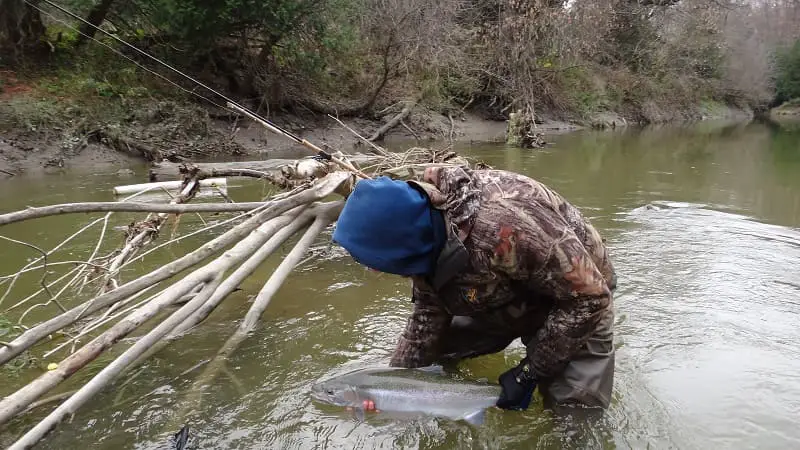
Float fishing for steelhead is one of the most productive ways to catch steelhead in a river. Many river guides in the Great Lakes region and on the West Coast float fish for steelhead.
I’ve taught thousands of anglers how to float fish better using the “four fundamentals of float fishing.” I’ll discuss that and more here.
What Is Float Fishing For Steelhead?
Float fishing steelhead is when you suspend your bait below a specialized bobber that is designed for river fishing, and you allow the bait and bobber to drift naturally down the river with the current.
Getting Started In Float Fishing
I will cover all the essentials of good float fishing.
- Gear: gear selection includes rods, reels, lines, floats, hooks, and leaders.
- Setup: Use my proven leader setup.
- Presentation: this is the key to catching the most steelhead possible.
- Covering the water: I have methods for systematically covering the water more effectively.
- Depth: You need to be sure your bait is deep enough. There are ways to figure this out.
- Bait Selection
- Speed Control: this is likely the most important thing to master
Steelhead Float Rods
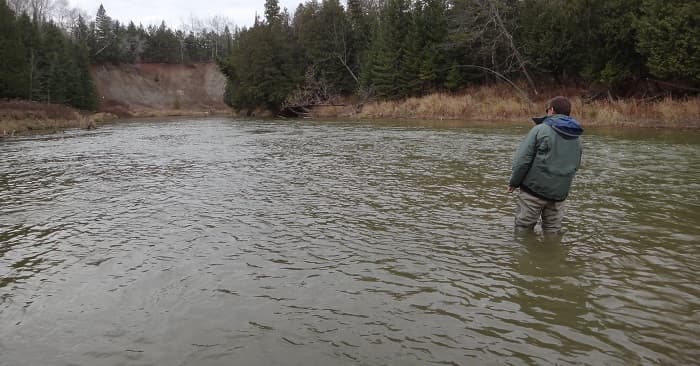
Float fishing for steelhead requires a long float rod in the 12 to 14-foot range. The bigger the river, the longer the rod, some anglers will use 14 to 16-foot rods. The long rod protects light leaders from breaking, keeping your line up off the water for longer and greatly improving your presentation.
I use mostly 13-foot float rods on rivers that are from 20 feet wide to 100 feet wide.
If you’re in the market for a float rod, check out my page 5 Best Centerpin Rods Of 2021. I use Centerpin rods with spinning reels and Centerpin reels.
Steelhead Float Reels

Float reels can be spinning reels, baitcasting reels, or Centerpin reels. Spinning reels and Centerpin reels are the most common reels used for steelhead fishing with a float because they tend to work the best.
The best reel to fish a bait under a float is the Centerpin reel because it provides you with the smoothest and most controlled drift with very little effort.
Spinning reels are good for drifting a bait below a float, but the line does not come off the reel as smoothly as a Centerpin reel.
Presentation is the key to more fish when fishing for steelhead.
If you are interested in Centerpin reels, check out my page 23 Best Float Reels Of 2021: Buyers Guide.
If you still prefer to use a spinning reel, check out my page 4 Best Spinning Reels Float Fishing.
I have guys ask if it is possible to use a fly reel, baitcasting reel, or a mooching reel, to float fish, and the answer is yes and no. The best reel for float fishing is the centerpin reel due to the way it works. See my article Centerpin VS Fly Reel and Other Float Reels.
Float Fishing Lines For Steelhead
Most anglers use Monofilament lines but braided lines can be good too. You will need a good line for drifting a float for steelhead. The best lines for steelhead will be:
- Light – Light and thin lines do not sag between the rod tip and the float as easily.
- Thin – Thin lines cast better and are more manageable.
- Strong – You want a line strong enough to land the biggest fish in the system, but do not go strong, or it won’t be light and thin.
- Buoyant – Buoyant lines mend and do not drag, and you will get much better hook sets if the line is on the surface.
If you want more on the best float lines, check out my page 5 Best Float Lines.
I also discuss the best line sizes when float fishing for salmon on my page Float Fishing For Salmon: Advanced Tactics for Great Lakes Salmon, and I discuss the best line sizes on my page Float Fishing For Trout- Expert tips and tactics for more trout.
Steelhead Floats: Bobber Fishing Steelhead
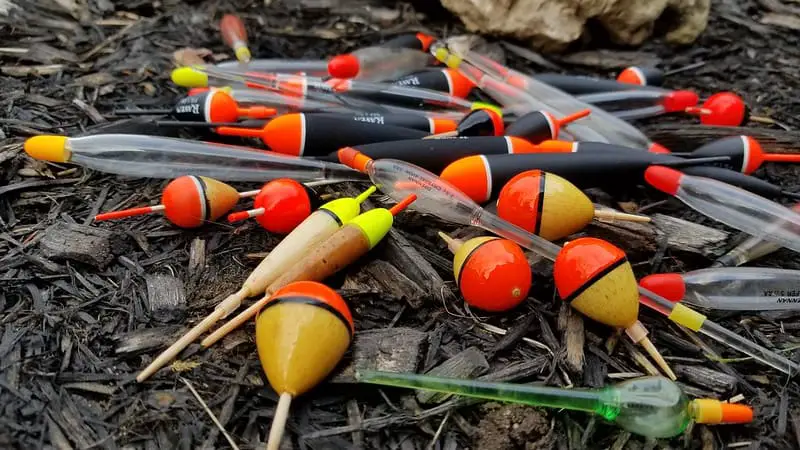
If you think that all a float really does is just suspend your bait, and to help you see when a fish bites, you will always struggle to catch steelhead.
The best steelhead floats are ones that are designed for steelhead fishing in rivers. They will be narrow with a pointed top and will be sensitive to help you detect strikes and the bottom. The right float will greatly improve your presentation and help you catch more steelhead.
If you are going drift baits under a float for steelhead, you might as well do it right with the right float. Check out my page 5 Best Centerpin Floats For 2021
What Size Float For Steelhead?
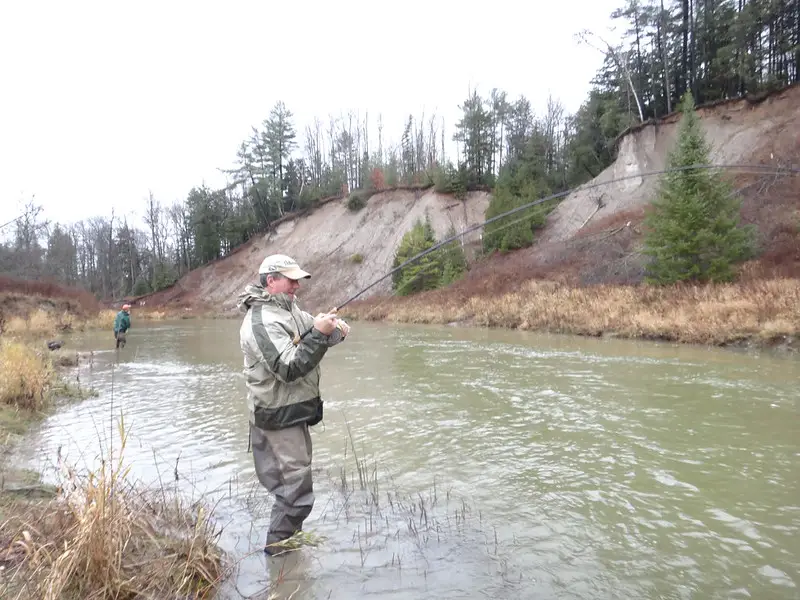
Use the float size that matches your river. The more weight you need, the bigger your float needs to be, and on deeper, faster rivers, more weight is usually required.
- 12 to 14-gram floats: for steelhead fishing on big, deep rivers.
- 6 to 10 gram floats: Medium-sized rivers.
- 2 to 5 gram floats: Small to medium-sized rivers.
My go-to float is a Raven FM 6.2 gram float for most rivers that I fish because I often have older clients who have trouble seeing the smaller floats.
The Steelhead Float Fishing Rig
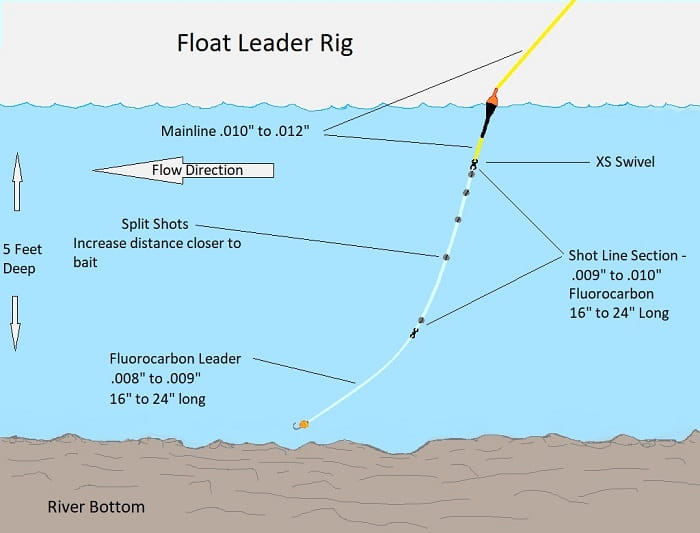
It’s very important to set your line up properly, which includes everything from your float, the swivels, the weight, and the proper placement of the weights, as well as the leader line and the hook.
Get all of this right, and you will catch more fish, one wrong thing could mean no steelhead for you.
Use A Shot Line
Use a “Shot Line” as part of your leader line instead. A shot line is a short 12 to 30-inch piece of line between your lower leader line and your mainline, and it is where all your split shots go. See the above diagram.
The shot line allows you to use a brightly colored mainline, which I highly recommend, especially for beginners.
I have an entire page dedicated to the steelhead float rig and how to set up the shot line. Check it out at Float Leader Setups Used By River Guides. This rig is actually very important to presenting the bait and getting the right angle, especially in faster water.
Weight Placement And Angles
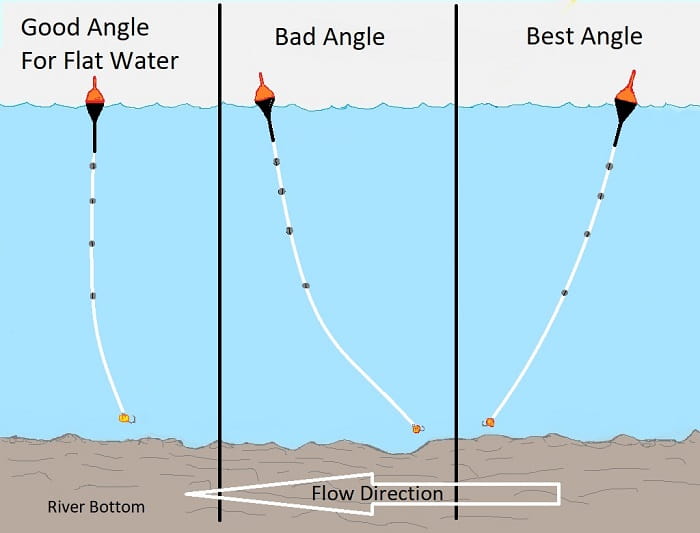
How you weigh your leader and shot line is very important and can make a huge difference in how many bites you get, as well as how many bites you detect.
The split shots are set up on the shot line in a way to provide you with ideal leader angles and ideal bait depths.
Float Leader Setup For Fishing Deep Water: When fishing deep water, you want the bulk of your weight deep and down on the shot line closer to your bait.
Float Leader Setup For Fishing Shallow Water: When fishing in shallow water, which is 6 feet or less, you want the bulk of your weights higher on the shot line and closer to your float.
Float Leader Setup For Fishing Fast Water: When fishing in faster water, you may need to add more weights to the shot line or use a bulk shotting leaders, which puts all the weights lower and closer to the bait on the shot line.
Checking Your Float Or Trotting Your Float
The weights on your leader are set up in a way to help you get a controlled drift and a good angler that ideally puts your bait slightly ahead of your float.
You can and should use a method called “checking your float” or “trotting your float.” This simply means creating some light and controlled tension on the mainline to hold the float back or slow it down a little, which kicks the bait out in front.
In my experience, If you do not do this, almost always, especially in faster water, the float will lead first because the surface current is faster, and the weight and bait drag, so the float will pull or drag the bait down the river. This can unnaturally increase the speed of your bait, which can prevent steelhead from biting.
How Much Should You Check Your Float?
Don’t be misled by anglers telling you to try and check your float hard and to get crazy angles that put your bait way out in front of your float, this can be a huge mistake, especially when it comes to strike detection and it will limit your success.
The reason guys want the bait ahead of the float and why they think it is important is that they believe that the steelhead should see the bait first so it’s not spooked by the line, weights, or float. This is only partially true and is not the primary reason why a bait first presentation is best.
Unfortunately, this belief makes guys think the farther the bait is in front of the weights and float, the better it is, the more steelhead they will catch, but this is wrong! In fact, it’s the opposite.
In fact, in some cases, if your angles are wrong, the steelhead will grab your bait and spit it out, and you won’t even know it.
The problem is that if your leader is almost horizontal and the bait is 5 feet out in front of your float, and a fish grabs it, the float will not move. The float needs to drift 5 feet to get over the steelhead, and then another five feet past the steelhead before it pulls under from tension. This ten-foot (2 to 5 seconds ) delay is more than enough time for a steelhead to spit the bait out.
And, trust me, steelhead will spit a bait out fast if they sense anything wrong, or feel the hook, or the line.
This is why I always recommend that your bait never be more than a foot or town in front of your float and on a more verticle angle.
Avoid what some anglers call the “horizontal drift”!
Slowing your bait down is the primary reason to check or trot your float. But you do not need to check hard to get the right bait speed.
How Much Line Below Your Float?
The length of line below your float should be the same as the depth of the water you are fishing or, in some cases, about 12 inches longer than the depth to accommodate for the out-front angle of your leader.
Do not drag the bottom!!
Based on actual studies that show trout (steelhead is basically an oversized rainbow trout) feed upwards over 80% of the time, you are better off being 20 inches over the steelhead’s head than one inch under their heads.
It can be difficult to know how deep to set your float, but I explain how I do it in another article.
What Pound Test Leader For Steelhead?
The proper leader brand and the right pound test are very important things to consider. I have witnessed anglers use a perfect set-up leader but still catch no steelhead simply because the leader was too thick.
Pound Test | Diameter Size | Method | River | Area |
6 pound | 0.007 in. / 0.18 mm | Float Fishing | - Small to Medium / Under 60 feet wide - Clear Water | Great Lakes |
8 pound | 0.008 in. / 0.20 mm | - Float Fishing - Bottom Bouncing - Plunking | - Small to Medium / Under 60 feet wide - Clear water | Great Lakes |
10 pound | 0.009 in. / 0.22 mm | - Float Fishing - Drift Fishing and Bottom Bouncing - Plunking | - Larger Great Lakes Rivers and faster currents - Off colored rivers - Small West Coast Rivers | Great Lakes and West Coast |
12 pound | 0.010 in. / 0.25 mm | - Lure Fishing Great Lakes - Float Fishing West Coast - Drift Fishing West Coast - Plunking on West Coast | - Large Great Lakes Rivers - Small to Medium West Coast Rivers | Great Lake and West Coast |
14 pound | 0.011 in. / 0.28mm | - Float Fishing on West Coast - Drift Fishing on West Coast | Medium to Large Rivers | West Coast |
16 pound | 0.012 in. / 0.31mm | Lure Fishing | Large to XL | West Coast |
I discuss this more on my page, What Pound Test Leader Is Best For Steelhead?
What Is The Best Hook For Steelhead?
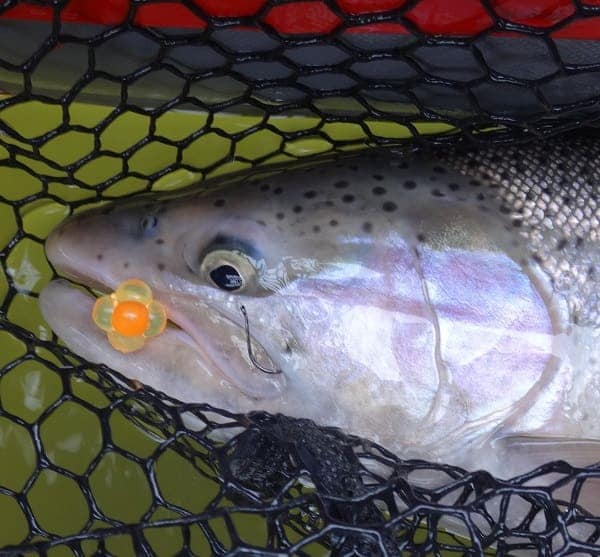
Different conditions and different baits will require different hooks, so it’s good to know what hook to use and when. The wrong hook can mean fewer fish.
I tell my clients to get a good hook like the Raven Specimen hook, Gamakatsu Octopus, or Sabertooth hook from Blackbird, and then match the size of the hook to the size of the bait.
Check out my page on the Best Float Hooks for more detailed information.
Baits
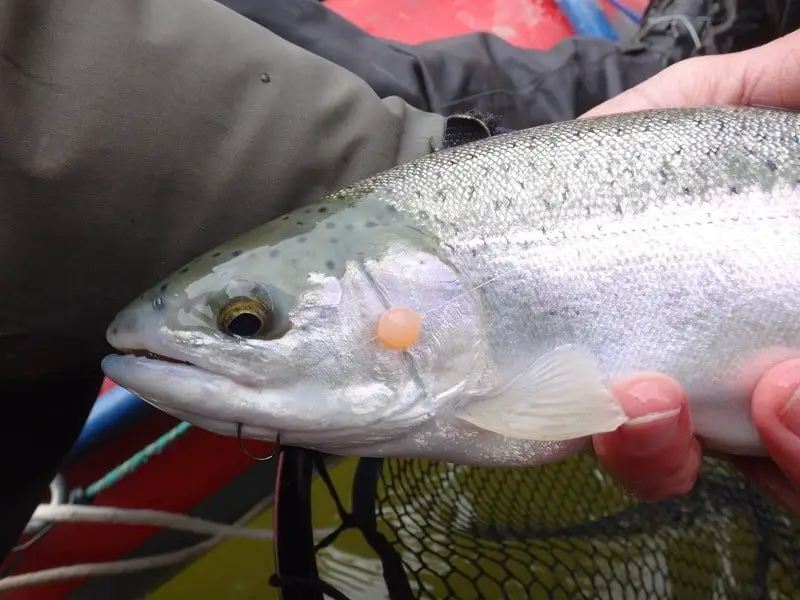
I tend to rotate through the same baits when I fish for steelhead, and there are some baits that consistently catch a lot of fish. I call these high percentage baits.
The right bait can make a big difference. The best baits under a float are the 3-inch plastic worm, the spawn bag, beads are also an excellent bait, and I also think that insects, can at times be one of the best baits to use under a float.
I discuss using flies under a float on my page Float Fishing With Flies: Expert Advice
I have an entire page on my favorite baits that I use for steelhead.
Steelhead Float Gear
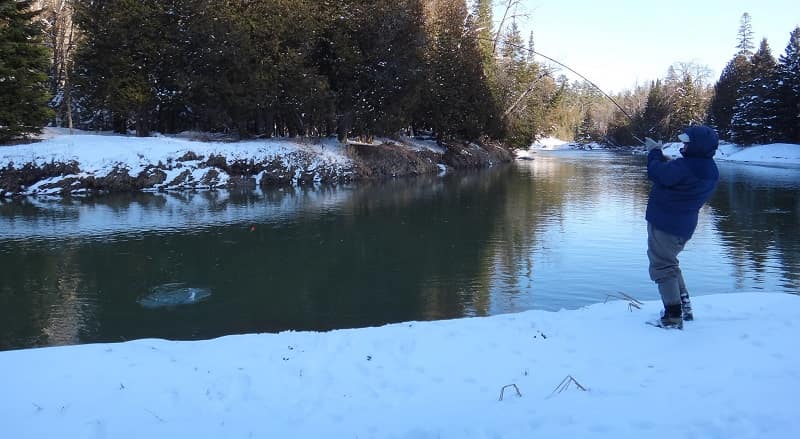
The steelhead fishing gear will make your day more comfortable and more enjoyable. The gear I am talking about includes waders, wading jackets, vests or packs, nets, forceps, polarized glasses, and more.
To make sure you have everything that you need for steelhead check out my page, River Fishing Gear: Everything You Need To Succeed In 2021.
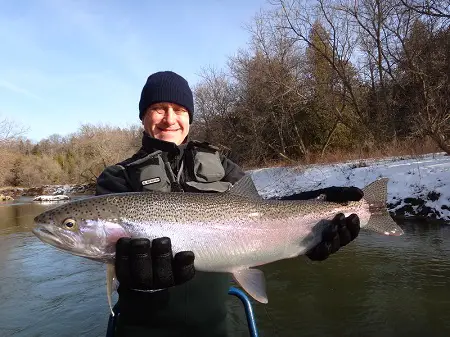
Even specialty stuff that will keep you warm during the colder months is something you should consider.
Winter steelhead fishing can be excellent, and since steelhead fishing in the winter requires a slower presentation and often a deeper presentation, you can go wrong with using a float and bait.
But winter steelhead fishing can be brutally cold if you do not dress warm.
It can also be very difficult to catch steelhead in ice-cold winter water unless you know the winter steelhead fishing methods that guides use.
I have a page all about tips and tricks so you don’t freeze your butt off in the winter on my page Fish And Stay Warm In The Winter With These 10 Tips.
How To Float Fish Like A Pro
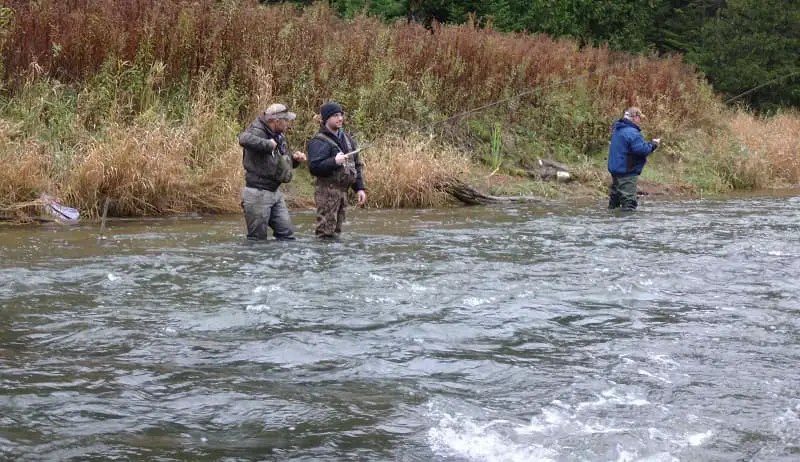
The last thing you will need to know is actually how to float fish which means how to present your bait in a way that maximizes your chances of a steelhead grabbing the bait, this is the float fishing technique.
The presentation is very important, and I have watched hundreds of anglers do it wrong and not catch any fish while I or my clients are catching many.
Float fishing in slow water is different than fishing in faster water. Many anglers think fit involves just casting out your float and bait, and then watching it drift. Expert anglers don’t do this.
I tell my clients that experts work their floats all the way down the river, controlling the speed as they go. This is critical, and it makes a massive difference in how many steelhead you can catch.
There are four float fishing fundamentals you need to know to be very effective and maximize the amount of steelhead you catch. It would take an entire page for me to explain it to you, so you should check out my page Centerpin Fishing: An Expert Centerpin Guide Explains It.
Tight Lines
Graham

Hi Graham, I have a couple questions about some local rivers in the Alliston area. I was wondering if the steelhead would still be in the Boyne river this time of year and if you think it would be worth the time to try and fish it or if I should focus my time on a different river with more fish. I was also wondering how far up the Nottawasaga the steelhead normally go and if it’s any good trying the smaller sections upriver of highway 89. Also if there are any smaller trout rivers/streams that have good numbers of fish that aren’t to far of a drive from Schomberg as I am 16 and have to rely on my parents driving me places.
Thanks, Alex
Hey Alex, Unfortunately, I’m not going to be able to give you information on spots on here. You asked for the smaller rivers with good numbers of fish in your area but, if I say where they are on a public website like this, those small rivers might not be very good for very long. There are lots of rivers and creeks with trout in them that are not too far from you but the hard part is finding access to them since it is mostly all private property up there. Check out the posts on this other website which might give you some ideas as to where to try in your area. https://ontariotroutandsteelhead.com/category/ontario-rivers
Ok thanks I will take a look.
Thanks for all the great information on this site. I’ve been able to land a few steelhead on my centerpin because of it.
I have a question about controling the drift. My float often seems to run towards the bank I am standing on, so I get a sideways drift, especially at the end. I also see this happening to other anglers in the pool. I try to follow the float and keep the line of the water, but this still seems to happen. I am using a 13 foot rod and 10 lbs Raven mainline. Do you follow the float with the rod tip or maintain an angle between the rod tip and the float to “guide” it down the drift? I hope this made sense. I’m wondering if it is a common problem with new float anglers.
Thanks again.
Hi Alex,
It’s common for the float to come towards the shore that you are fishing because of the micro drag that is being caused by your reel. In most cases, it is ok that this happens if it is slightly coming in closer. To alleviate this a bit I will do two things. #1 Keep your rod tip straight out towards the middle and second, move further out into the river. Keeping your float directly below your rod tip will prevent the float from tracking in close to your bank. On super long drifts, (50 feet plus) I will start slowly pointing my rod tip towards the float to ensure a better hookset, but with drifts of 30 or 40 feet, your rod tip straight out will be fine. Good luck.
Thanks for the reply. I appreciate all the information on the site. It has really helped me get on some fish. Thanks again.
Hi Graham! I’ve just started reading you artic look es, and really enjoy them!
I live in Oregon, and fish some rivers that you Great Lakes anglers would consider big, and fast. The thing that confuses me the most us the weight of your floats. Yours are measured in grams, and out here, ours are measured in ounces. It seems impossible to get good equivalents in ounces for your gram weights. Do you have any suggestions as to how to get accurate conversions? Any help would be greatly appreciated.
Tight lines, and fish on to you!
Brian Adler
Hey Brian,
Unfortunately, I don’t know floats and ounces. I don’t see why you couldn’t you a conversion app like https://www.google.com/search?client=firefox-b-d&q=grams+to+ounces+conversion
Hi Graham, Can you suggest a shot line setup that will work for most waters? I typically fish medium, to larger waters. Whats a good length of shot line, and then leader length for medium/larger waters (like Maitland). I have always used fixed fload > 8lb mainline > xxs micro swivel > 6lb fluro leader (froghair) > bait. I have never used a shotline, but I’m open to trying something new to help with my hookup percentages and getting infront of the fishes faces more. Thank you!
Hi Ray,
Don’t overthink it. For most rivers like the maailand or Saugeen, I use the same shotline on this page. You shot line diameter should be the same or slightly less than your mainline, but heavier than your bottom leader section. I discuss line and leader diameters in the link below because mainlines are rarely rated properly. I may go with the longer shot line of 24 inches if all the water is deeper 6 to 12 feet, but if there are shallower spots my shot line is around 16″. I have shot line diagrams for different water types and depths at this page
Good Luck,
Graham
HEY GRAHAM, tRYING TO FIND GOOD STEELHEAD GUIDE FOR FALL FISHING PA RIVERS. ANY RECOMMENDATIONS BE FOR MYSELF AND 16 YO. THIS IS A BUCKET FISHING TRIP FOR ME
Hey Steve,
It depends on the type of fishing you want to do. Most guides in PA only fly fish.
These are guides I’ve heard good things about.
Keystone Anglers Guide Service
Wildwood Outfitters
Trout Yeah Guide Service
Goose’s Steelhead Fishing Guide Service
Graham